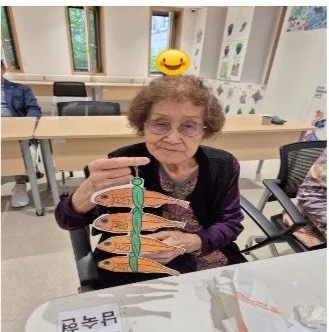“Every morning she picks out her outfit for school”: How Korea’s elder kindergartens are transforming aging
By 2030, a quarter of Korea’s population will be over 65, making it one of the fastest-aging nations in the world. While countries everywhere are bracing for the social and economic ripple effects of longevity, Korea has pioneered something both practical and heart-warming: the Noein Yuchiwon — literally translated as “elder kindergarten.”
These centers look and feel like schools, but instead of children, the students are older adults like Nam Sook-hyun, a 90-year-old Seoul resident whose daughter, Choi Myoungsil, 66, shared her story with AgeTech Journal.
Nam Sook-hyun, 90, holds up her fish cutout art project during a creativity session at her elder kindergarten. The photo was included as part of her monthly progress report to family.
What is an Elder Kindergarten?
Elder kindergartens are day-care style programs for seniors. Participants arrive in the morning, spend the day in structured programs, and return home in the evening.
The daily schedule blends social engagement, meals, health monitoring, and rehabilitation activities:
Arts & crafts like folding paper flowers or painting.
Cognitive games that support memory and focus.
Group exercise and physical therapy, using tools like resistance bands or low-impact machines.
Nutritious meals tailored to seniors’ health needs.
Medical check-ins, including blood pressure and glucose monitoring.
Each month, a report card is sent out to Sook-hyun’s family, including health updates, therapy notes, and photos of artwork —- reminders that their loved ones are not only cared for, but thriving socially and creatively.
Nurses track her blood pressure, blood sugar, and weight, to ensure her health is stable. Each elder kindergarten is staffed with nurses, aides, and physical therapists, who record observations and progress notes in the monthly report card.
Her daughter says:
“I suggested that [my mother] try out an elder kindergarten because before she was at home by herself all day. She initially refused, saying she didn’t want to go. ‘Let’s just try it out for a month,’ I told her.”
Now, Sook-hyun loves school.
“Every morning she picks out her outfit for school,” says Choi. “She wakes up and changes her clothes, shoes, and bag. When she gets on the bus, she’s waving at everyone —- it’s a whole thing.”
After a full day of socializing and activities, Sook-hyun now sleeps soundly at night.
Why Korea Leads the Way
Korea is often called the aging capital of the world. Rapid industrialization, urban living, and declining birthrates mean fewer children are available to care for parents. Government policy encourages families to use community-based solutions like Elder Kindergartens instead of relying only on at-home care.
Costs typically range from 700,000 to 900,000 KRW per month ($500–650 USD), but government subsidies cover the majority of expenses, leaving families to pay only about 10-15 percent out of pocket. The exact subsidy depends on each senior’s assessed ‘level’ of disability or dependency.
A Day in the Life of Nam Sook-hyun
Here’s a snapshot of her daily schedule at the elder kindergarten:
9:00 AM – Pickup & Arrival
A community shuttle bus collects seniors from their homes. Sook-hyun greets the driver, chats with neighbors, and waves at passersby — her “morning ritual” that makes her feel like she’s going to school again.9:30 AM – Morning Health Check
On arrival, nurses check blood pressure, blood sugar, and weight. These are logged into her monthly report card and reviewed by staff.10:00 AM – Group Exercise
Low-impact stretching, resistance band training, and light physical therapy guided by an aide or physical therapist. Designed to improve circulation and mobility.11:00 AM – Cognitive Activities
Programs like Sound Flowers (using music and sound recognition to support memory) or Cognitive Math Games that challenge focus and recall.12:00 PM – Lunch
A hot, balanced Korean meal: rice, soup, kimchi, and a protein like grilled fish or bulgogi. Meals are tailored for senior nutrition.1:00 PM – Rest & Social Hour
Time to relax, nap, or chat with peers over tea. Some seniors use this time for light hobbies or card games.2:00 PM – Creative Session
Arts & crafts, painting, or seasonal projects. Recently, Sook-hyun made a collage of colorful fish cutouts — a photo of her smiling with the artwork was included in her family’s monthly report.3:00 PM – Snack & Music Time
Light snack such as rice cake or fruit, often paired with group singing or a cultural activity.4:00 PM – Specialized Therapy
Sessions with heat therapy pads, air compression for legs, or low-frequency electrical therapy to ease discomfort and support mobility.5:00 PM – Closing Activities
End-of-day programs may include storytelling, small group games, or preparing for the bus ride home.6:00 PM – Shuttle Ride Home
She boards the bus, waves enthusiastically to staff and neighbors, and returns home.
The schedule is designed to support cognitive health, social connection, and physical mobility.
Meals: Nutrition for Longevity
Diet is a cornerstone of longevity in Korea. Elder kindergartens provide three balanced meals a day plus snacks. In October, the menu included:
Breakfast: Pumpkin porridge, egg rolls, side vegetables.
Lunch: Soybean paste stew, grilled mackerel, and seasonal kimchi.
Snack: Rice cake or banana.
Dinner: Soft bulgogi with tofu stew.
Why This Matters Globally
Korea’s Elder Kindergarten model provides a blueprint for aging societies worldwide:
It reduces caregiver burden on adult children.
It delays institutionalization by keeping older adults engaged.
It improves quality of life and mental health for seniors.
With the global population aged 60+ projected to double by 2050, elder day-care programs will become increasingly critical — not just in Korea, but everywhere.
